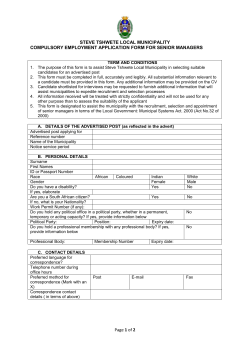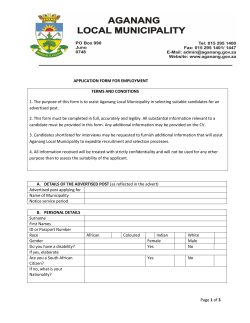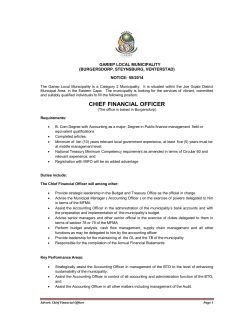
Agenda of Ordinary Meeting - 17 March 2015
ATTACHMENT TO AGENDA ITEM Ordinary Meeting 17 March 2015 Agenda Item 5.5 2015 Electoral Representation Review Attachment 1 Preliminary Submission - Council Electoral Representation Review ........................................................ 66 Attachment 1 Preliminary Submission - Council Electoral Representation Review Preliminary Submission Council Electoral Representation Review Greater Shepparton City Council Greater Shepparton City Council Gavin Cator Chief Executive Officer Locked Bag 1000 SHEPPARTON VIC 3632 Council Contact Sharlene Still Acting Manager Corporate Performance Ph: 03 5832 9869 Email: sharlene.still@shepparton.vic.gov.au Agenda - Ordinary Council Meeting – 17 March 2015 - 66 - Attachment 1 Preliminary Submission - Council Electoral Representation Review Summary and Recommendation Greater Shepparton City Council has considered the options for the electoral structure of the municipality. The Council is committed to a whole of municipality approach to ensure the promotion of social connectedness and a sense of identity. It is the views of Council that the current electoral structure provides a framework for the consideration of a diverse range of views, and opportunities for all communities of interest that participate in the process of Local Government. The Greater Shepparton City Council recommends that the current unsubdivided electoral structure, with 7 Councillors, be maintained as the model that would provide the electors of the municipality with the most effective and equitable representation for the future. Electoral Overview Greater Shepparton City Council is currently represented by 7 Councillors in an unsubdivided municipality The current electoral structure was determined as a result of an extensive community consultation process in 1996. There was a consistent view that Councillors need to have a municipality wide focus, and be responsible for representing the municipality as a whole. Unsubdivided Municipality The Council is of the view that an unsubdivided municipality has proven to provide for the most effective representation for the Greater Shepparton community 1997. The City of Greater Shepparton comprises an area of 2,422km2. The population is largely concentrated in the major urban growth areas of Shepparton, Mooroopna and Tatura. These centres are surrounded by a number of smaller communities. Council recognises that the urban and rural areas are mutually reliant upon each other. This mutual reliance promotes and encourages the existence of a common community interest across the municipality. An unsubdivided municipality allows for equal representation of all residents, by all councillors. It promotes a strategic view by Councillors and allows the Council to take a municipality wide approach to decision making. It also promotes increased accountability, as opposed to individual ward interests. Councillor representation in Greater Shepparton demonstrates a wide spread of geographical representation, with no dominance by any particular group or location. An unsubdivided structure provided more opportunities for the community to access their elected representatives. Residents and ratepayers can choose any Councillor when wishing to discuss concerns or raise issues of Agenda - Ordinary Council Meeting – 17 March 2015 - 67 - Attachment 1 Preliminary Submission - Council Electoral Representation Review interest. It allows individual Councillors to be accessed based on policy interest or expertise. It also allows Councillors to freely share workloads and commitments. An unsubdivided structure eliminates the confusion about the electoral makeup of the municipality in respect to elections, and Councillor representation. Under a ward model, residents may find it difficult to identify their ward, and their Council representative. Further confusion can occur when ward boundaries are reviewed, and changes are made to maintain voter to Councillor ratios. The unsubdivided model provided an opportunity for voters to express a preference for every candidate in the Council election, rather than the limited number of candidates under a ward structure. Number of Councillors Since the restructure of local government in Victoria in 1997, Greater Shepparton has been represented by 7 Councillors. It is the Council’s view that this is appropriate and workable for this municipality, as it effectively allows for streamlined decision-making, and optimal representation and accessibility for the various communities of interest. An uneven number of Councillors is preferred, as it reduces the likelihood of the mayor requiring to use a casting vote. Greater Shepparton’s current ratio is 6330 voters per Councillor. This is higher than the average of regional and rural Councils; however, Greater Shepparton’s geographical area is smaller. An increase in Councillors will increase the cost to the ratepayers. Conclusion It is the view of the Greater Shepparton City Council that this structure has worked well for the community and the organisation since 1997. The unsubdivided structure has provided for the most effective representation for the Greater Shepparton community, and has been embraced by the community as a whole. The Council also believes that the current number of Councillors has proven to be appropriate and workable for this municipality, effectively allowing for streamlined decision-making, and optimal representation and accessibility for the community. On conclusion, the Greater Shepparton City Council recommends that the current unsubdivided electoral structure, with 7 Councillors, be maintained as the model that would provide the electors of the municipality with the most effective and equitable representation for the future. Agenda - Ordinary Council Meeting – 17 March 2015 - 68 -
© Copyright 2025












